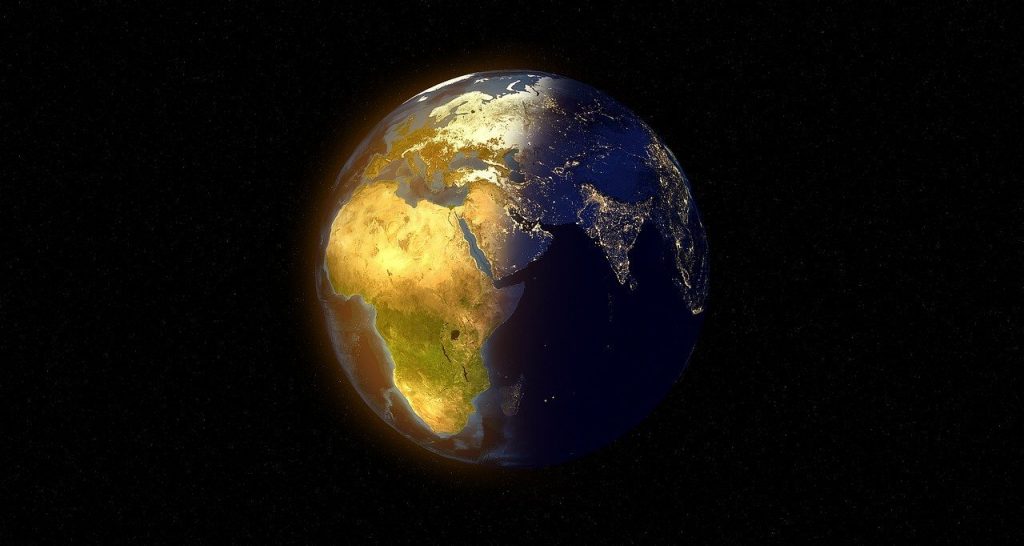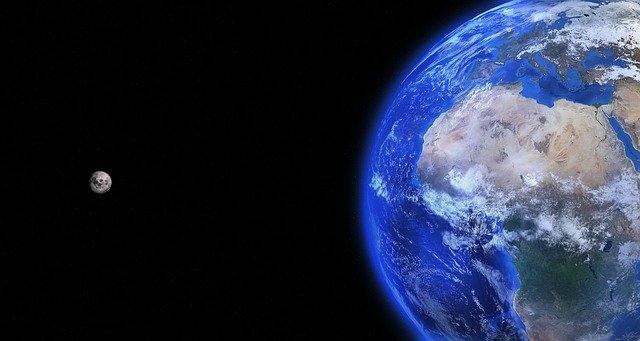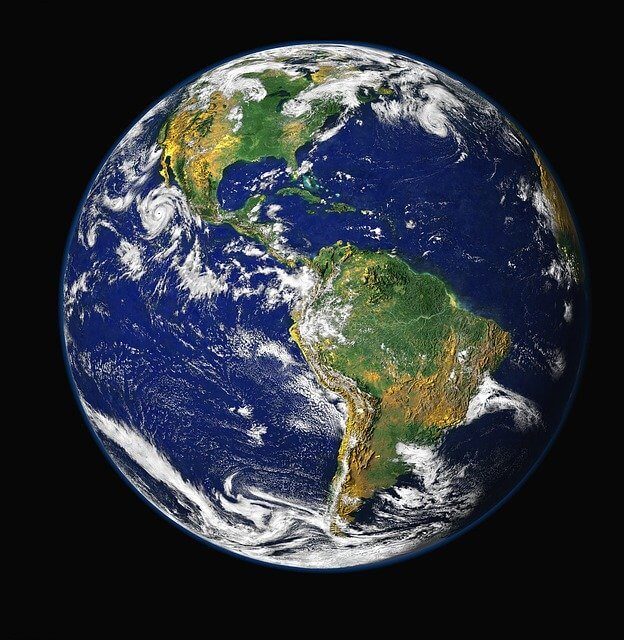Earth is the third planet in the solar system, in orbit around the Sun between Venus and Mars, that is, 149,600,000 km from the Astro Rey.
It is the largest and densest of the so-called Terrestrial planets, and the fifth in size of the eight that exist. It is also the only planet to date capable of hosting organic life as we know it.
Its name comes from the ancient Roman mythology: Terra, incarnation of a primitive goddess who was associated with femininity, fertility and the origin of most things. It is associated with motherhood in various cultures, such as the Pachamama of the Incas or Western Mother Earth.

The Earth has a unique natural satellite that we call the Moon, in orbit only 384,400 km away from the surface. The Moon is the fourth largest satellite in the solar system and measures a quarter of the Earth.
Characteristics Of Earth
1. Origin and formation
The origin of the Earth and of the other planets is in the solar nebula, a disc of matter remaining from the formation of the Sun itself. It has been calculated that 4550 million years ago the Earth existed, after a period of cooling and constitution about 10 to 20 million years ago, the end result of which was the conformation of the outer layers of the Earth’s surface and the Moon, the result of an impact between a body roughly the size of Mars and Earth about 4530 million of years.
Then there was a gradual degassing of the planet’s crust, which together with the incipient volcanic activity, initiated the chemical processes that would result in the Earth’s atmosphere. Similarly, the appearance of water from the oceans, a prelude to life, was due to the introduction of ice and liquid water into comets, asteroids or protoplanets that made an impact on the young Earth.
2. Movements
The Earth has three different forms of movement: rotation, translation and obliquity.
Rotation. The Earth revolves around its own axis, in a West-East direction, and it takes 23 hours, 56 minutes and 4 seconds to complete a turn. This movement gives rise to day and night, alternating between the face exposed and hidden from the Sun.
Translation. The Earth’s orbit around the Sun has a perimeter of 930 million kilometers, at a speed of 108,000 kilometers per hour. That means that a full orbital lap takes place every 365 days, 5 hours, 48 minutes and 45 seconds. This period is what we commonly call the year.
Obliquity. The Earth is tilted on the plane of its elliptical at just over 23 °, and is responsible for the seasons of the year, as it brings and moves certain planetary latitudes to the Sun. This movement decreases at a rate of 0.47 “per year.

3. Atmosphere
The ball of gases that surrounds the Earth’s surface, subject to its gravity, is called the atmosphere. It consists of 78% nitrogen, 21% oxygen and the rest of noble gases and extends from the earth’s surface to about 11 km in height (in 75% of its content). However, there are no definite limits of the atmosphere, since it begins at some point to vanish in space.
Atmospheric nature is due to climatic phenomena and the redistribution of thermal energy, as well as the appearance of the ozone layer, essential for the preservation of life from the direct impact of the Sun’s UV radiation.
4. Composition and internal structure
The Earth belongs to the terrestrial planets, that is to say, that is a rocky body and not gaseous, like Jupiter. The terrestrial body is composed of different levels or geological layers, namely:
Lithosphere. Composed by the terrestrial upper surface, crust and mantle, it is the layer that extends from 0 to 60 km deep. It is the coldest and most rigid layer of all. The tectonic layers are composed of it.
Astenosphere A viscous layer on which the lithosphere floats, goes from 100 to 700 km deep.
The mantle. This is the name given to the layer between 35 and 2890 km depth, although it is a series of different geological levels.
External nucleus. A liquid layer of matter, of very low viscosity, that surrounds and rests on a solid core.
Internal core. The central sphere of the Earth, composed mainly of iron, nickel and low percentages of sulfur and oxygen. The core in total is 3500 km thick
5. Proportions
Of the terrestrial planets, the Earth is the most dense, possessing the most intense magnetic field and the highest surface gravity, in addition to the fastest rotation. This molds it like a flattened sphere (oblate spheroid) at the height of its poles, and bulging slightly at the height of the equator.
It has an equatorial circumference of 40,091 km, a diameter of 12,756 km and a mass of 5.9736 × 10^4 kg.
6. Surface
The total area of the Earth is 510,072,000 km2, of which 70.8% is water and the remaining 29.2% is land. The relief of this exposed surface is a combination of mountains, deserts, plains and plateaus, while the submerged one possesses canyons, plateaus and submarine ridges, as well as deep abyssal plains, where sunlight does not reach.
The earth’s surface is modified over the years, due to the underground movement of the tectonic plates, whose folds and collisions generate various relief phenomena.

7. Biosphere
The biosphere is understood as the total set of organic life on the planet, in the context of its physical locations. Divided into several biomes, according to its latitude, height above sea level and humidity margins, it is estimated that it has begun to evolve 3,500 million years ago.
The planetary biodiversity is very high, privileging for it the low and humid zones like the Tropical Forest, while the high and arid zones are not habitable for plant and animal life.
In each biome there are diverse ecosystems, in which life has organized itself from the possible relationships between living beings. The total mass of life on the planet is about 1 trillion tons of carbon.
8. Hydrosphere
A fundamental difference of the Earth with respect to other planets of the Solar System is its abundant presence of water. This total aquifer surface is known as hydrosphere, and encompasses not only the extensive oceans and seas, but lakes, rivers and groundwater up to 2 kilometers deep. The sum of this mass of water on the planet is 1/4400 of its total mass.
The oceans extend over an area of 361.84 × 106 km2, with an average depth of 3682.2 meters and a volume of 1.3324 × 109 km3. That means that if the land were leveled, the water would cover it completely up to 2.7m in height.
9. Magnetic field
The Earth’s magnetic field is the largest of the terrestrial planets. Its poles are identified with the geographical poles, although its origin is assumed in the movement of the metallic core of the planet, which generates electric currents.
This is how the magnetosphere is formed, the earth’s magnetic field that, among other things, diverts the solar wind particles. The dipole magnetic moment of the planet is estimated at 7.91 × 1015 T m3. This magnetic force weakens towards the equator.

10. Human population
Spread across the continents, we inhabit around the world some 7 billion human beings and this figure is expected to reach 9.2 billion by the year 2050. The most populated continent is Asia, and global statistics point to 40% of rural population versus 60% of urban population.
The various human nations (204 sovereign nations for the year 2011) have claimed almost all of the land surface, except for large areas of Antarctica and an unclaimed area between Egypt and Sudan, called Bir Tawil. Even so, barely an eighth of the earth’s surface is habitable by human beings.